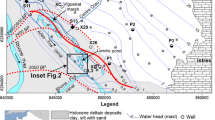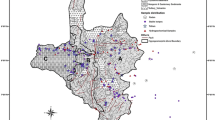Abstract
Tonle Sap Lake (Cambodia) is the largest freshwater lake in SE Asia, and is reported to have one of the highest freshwater fish productions anywhere. During the dry season (November–April) the lake drains through a tributary to the Mekong River. The flow in the connecting tributary completely reverses during the wet monsoon (May–October), adding huge volumes of water back to the lake, increasing its area about fourfold. We hypothesize that nutrients are at least partially delivered via groundwater discharge, especially during the draining portion of the annual flood cycle. We surveyed over 200 km in the northern section of the lake using a customized system that measures natural 222Rn (radon), temperature, conductivity, GPS coordinates and water depth while underway. Results showed that there were portions of the lake with significant enrichments in radon, indicating likely groundwater inputs. These same areas were generally characterized by lower electrical conductivities. Samples collected from nearby wells also showed a general inverse relationship between radon and conductivity. Our data suggest that groundwater pathways are important, accounting for roughly 10–20 % of the freshwater flow of the Tonle Sap tributary (connection to the Mekong River), the largest single source of fresh water to the lake. Nutrient inputs from these inputs, because of higher concentrations in groundwater, will be correspondingly higher.




Similar content being viewed by others
References
Lamberts D et al. (2007) In: 2nd international symposium on sustainable development in the Mekong River Basin, p 187
Kummu M, Penny D, Sarkkula J, Koponen J (2008) Ambio 37:158–163
Sarkkula J, Koponen J, Kummu M et al. (2003) Final report to the Mekong River Commission
MRC (Mekong River Commission) (2005) Overview of the hydrology of the Mekong Basin. Mekong River Commission, Vientiane (Laos), 73 p
Lamberts D (2006) Water Resour Dev 22:481–495
Lamberts D (2008) In: M. Kummu M, Keskinen M and Varis O (eds) Modern myths of the Mekong, Water and Development Publications, Helsinki University of Technology, Helsinki, pp 3–18
Varis O, Kummu M, Keskinen M, Sarkkula J, Koponen J, Heinonen U, Makkonen K (2006) Tonle Sap Lake, Cambodia: nature’s affluence meets human poverty. Case study for 2006 HDR, pp 1–8
Junk WJ, Bayley PB, Sparks RE (1989) Can J Fish Aquat Sci 106:110–127
Junk WJ (1999) Arch Hydrobiol Suppl 115(3):261–280
Burnett WC, Kim G, Lane-Smith D (2001) J Radioanal Nucl Chem 249:167–172
Dulaiova H, Peterson R, Burnett WC, Lane-Smith D (2005) J Radioanal Nucl Chem 263(2):361–365
Khattak NU, Khan MA, Shah MT, Javed MW (2011) J Radioanal Nucl Chem 290:493–505
Lee KY, Yoon YY, Cho SY, Ko KS, Yum BW (2012) J Radioanal Nucl Chem. doi:10.1007/s10967-011-1608-7
Cable JE, Burnett WC, Chanton JP, Weatherly G (1996) Earth Planet Sci Lett 144:591–604
Dulaiova H, Burnett WC, Chanton JP, Moore WS, Bokuniewicz HJ, Charette MA, Sholkovitz E (2006) Cont Shelf Res 26:1971–1983
Dimova N, Burnett WC (2011) Limnol Oceanogr 56:486–494
Dulaiova H, Burnett WC (2006) Geophys Res Lett 33:L05606. doi:10.1029/2005GL025023
Burnett WC, Cable JE, Corbett DR (2003) In: Taniguchi M, Wang K, Gamo T (eds) Land and marine hydrogeology. Elsevier, Amsterdam, pp 25–43
Acknowledgments
The authors thank Ms. Rawiwan Kritsananuwat and Mr. Sompop Rungsupa of Chulalongkorn University for their assistance in the field and in the laboratory. We also acknowledge several Cambodian colleagues who were instrumental in helping us complete our field research. These included Mr. Bunseang Suy and Mr. Veasna Chhan (Tonle Sap Rural Water Supply and Sanitation Sector Project), Ms. Leakhena Phuong (Pure Water Association), and Mr. Sothea Kok, Ms. Eliyan Chea, Ms. Sodaneath Hong and Ms. Thavin So, all of the Royal University of Phnom Penh. Financial support for this research was received from a grant from the National Geographic Society to Florida State University.
Author information
Authors and Affiliations
Corresponding author
Rights and permissions
About this article
Cite this article
Burnett, W.C., Peterson, R.N., Chanyotha, S. et al. Using high-resolution in situ radon measurements to determine groundwater discharge at a remote location: Tonle Sap Lake, Cambodia. J Radioanal Nucl Chem 296, 97–103 (2013). https://doi.org/10.1007/s10967-012-1914-8
Received:
Published:
Issue Date:
DOI: https://doi.org/10.1007/s10967-012-1914-8




